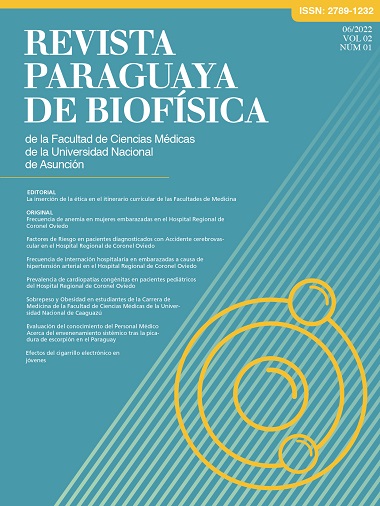Risk factors in patients diagnosed with stroke in the Regional Hospital of Coronel Oviedo
Keywords:
stroke, arterial hypertension, ischemiaAbstract
Cerebrovascular accident, also called ictus or stroke, is a brain injury that can also seriously affect the body. It occurs when the blood supply to a part of the brain is interrupted or when a stroke occurs in or around the brain. Knowledge of the etiological factors and mechanisms involved in the production of stroke is essential in order to establish a proper diagnosis and implement effective prevention and treat ment measures.
In this study the objective was to identify the modifiable and non-modifiable Risk Factors in patients diagnosed with stroke in the Regional Hospital of Coronel Oviedo during the year 2021.
A total of 69 cases of stroke registered inthe year 2021 were recorded in the study. Of which, 31/69(44.9%) patients were fe- male and 38/69 (55.1%) were male. The most affected age range for both sexes belonged to the 70 to 79 years age group, with 20/69 (29%) cases. The age range between 30 and 39 years was the one with the fewest cases of stroke for both sexes, with 1/69 (1.5%). In relation to the types of stroke, there was a greater pre- dominance of ischemic stroke, with 61/69 (88%) cases registered in that period. The most frequent modifiable risk factor was arterial hypertension, with a total of 61/69 (88.4%) patients with this factor. Finally, the mortality rate was 2.9%.
Downloads
References
(1) Bejot Y, Daubail B, Giroud M. Epidemiology of stroke and transient ischemic attacks: Current knowledge and perspectives. Rev Neurol (Paris). 2016;172(1):59- 68.
(2) Hitler Adolfo Vela Zuta. Universidad Nacional Toribio Rodríguez de Mendoza de Amazonas Facultad de Ciencias de la Salud Escuela Profesional de Tecnología Médica. “Accidente cerebrovascular”. Chachapoyas – Perú 2019.
(3) Impacto y proyecciones del accidente cerebrovascular [Internet]. SAVALnet. Publicado el 25 julio 2018.
(4) Ministerio de Salud Pública y Bienestar Social [Internet]. Paraguay. Tabaquismo causa más de 1.400 ACV en el país. Publicado el 25 de abril 2019.
(5) Miguel Kim L, Alet M, Claverie S, González L, Lepera S, Rey RC. ¿Los accidentes cerebrovasculares de hoy son iguales a los de hace 20 años? Análisis de etiolo- gías de enfermedad cerebrovascular. Neurología Argentina [Internet]. 2021 Apr 1.
(6) Joseph G. Rogers. “Accidente cerebrovascular. Blood, Heart and Circulation”. Instituto de corazón de Texas. [Internet]. 2002.
(7) Miryan Alexandra Arteaga Palma, Alberto Campos García y Sonia Nataly Roldan Quijije (2019): “Apoyo familiar en la recuperación de la salud de pacientes adul- tos mayores con secuelas de ECV (evento cerebro vascular)”, Revista Caribeña de Ciencias Sociales (julio 2019).
(8) Gamarra-Insfrán JL, Soares-Sanches Dias R, Fernandes -Sanches CJ. Risk factors associated with Ischemic Brain Accident in patients cared in a public hospital in Paraguay. Rev Inst Med Trop [Internet]. 2020.
(9) Weschenfelder Magrini D, Gue Martini J. Hipertensión arterial: principales factores de riesgo modificables en la estrategia salud de la familia. Enferm glob [Internet]. 2012
(10) Rodríguez Lucci F, Pujol Lereis V, Ameriso S, Povedano G, Díaz MF, Hlavnicka A, et al. Mortalidad intrahospitalaria por accidente cerebrovascular. Medicina (B Aires) [Internet]. 2013.
Downloads
Published
How to Cite
Issue
Section
License
Copyright (c) 2023 Luz Pamela Duarte Vera, Andrés Jesús Escandriolo Coronel, Melizza Isamara Florentín Rojas, Ludmila Flores Barreto, Felicia Galeano Cubilla Galeano Cubilla, Idalina Stanley

This work is licensed under a Creative Commons Attribution 4.0 International License.





